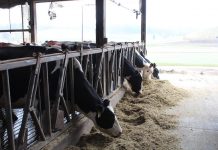Forages are under drought stress in many parts of the state. New seedlings are most severely affected, especially late planted fields.
New alfalfa seedings that have been harvested are regrowing slowly. They should survive the drought stress and initiate more vigorous growth once moisture returns.
In established grass stands, growth has been slow at best. Established grass stands can survive through severe drought conditions and regrow once rains return.
Withstanding dryness. Deep-rooted established legumes such as alfalfa have the best capacity to continue growth under dry conditions, but in the driest regions, alfalfa growth is limited. Alfalfa and birdsfoot trefoil have good drought tolerance, while red clover stands can be reduced during severe drought and heat stress.
Therefore, harvest management strategies are different for these legumes.
Alfalfa harvest. Alfalfa, unlike birdsfoot trefoil and red clover, can actually maintain production during short periods of dry weather (provided the soils allow development of a deep taproot). But some regions have experienced an extended period of drought and high temperatures, and the alfalfa is short and is in the bloom stage.
Cutting alfalfa under these stressful conditions usually does not harm the plant or cause stand reductions.
If moisture is lacking after cutting, alfalfa plants go dormant until sufficient moisture is again available for regrowth.
During the initial phases of moisture stress, alfalfa stems stop elongating, but the plant continues to manufacture carbohydrates. These carbohydrates are stored in the root system since they are not being used for top growth.
These energy reserves are available for regrowth after cutting and when soil moisture is recharged.
So if there is enough harvestable forage to economically justify a hay cutting, then go ahead and harvest it. You still should maintain about a 30- to 35-day interval from the last harvest.
Even though the plants may be in full flower, the forage will probably be higher in quality than normal growth in full bloom. If fencing is available, controlled grazing of drought-stressed alfalfa stands is an economical way to utilize the forage that is present, but bloat prevention strategies should be employed.
Red clover harvest. Red clover is not as tolerant to the combined effects of drought and heat stress as alfalfa. Cutting during periods of hot and dry weather can weaken red clover plants and may cause stand reductions.
If feed is badly needed, red clover stands can be lightly grazed during drought stress.
When cutting or grazing birdsfoot trefoil during periods of heat and drought stress, be extra careful to harvest when plants are at least in mid-bloom stage and leave a 3-inch stubble.
Birdsfoot trefoil maintains relatively low levels of reserve carbohydrates in the roots and crowns during the summer. Cutting or grazing when plants are well into bloom stage and leaving sufficient leaf area will improve its regrowth potential.
STAY INFORMED. SIGN UP!
Up-to-date agriculture news in your inbox!












